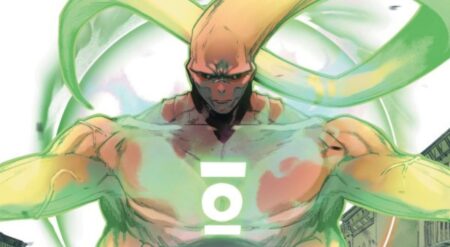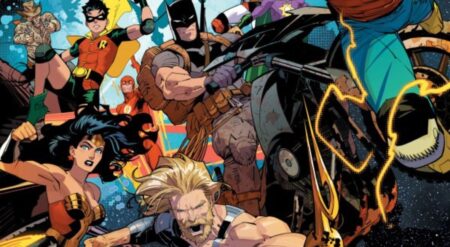The Flash #1 is published by DC Comics, written by Simon Spurrier, art by Mike Deodato Jr., colors by Trish Mulvihill and letters by Hassan Otsman-Elhaou. The Flash is trying to look after both Central City and his family, but something is wrong with the Speed Force.
Coming off of the Jeremy Adams run on The Flash, the tonal shift is the most noticeable part of the change of writers. Whereas the previous run was positive and lighthearted, this edition is much darker. There are horror elements to the book that lean towards the psychological as opposed to a frightening experience. Many of the speedsters are sensing that something has changed within the speed force. Some are actually experiencing pain when they run while others are starting to hallucinate. But in almost every setting, there is unease. Whether it be at Wally’s home, at work, or out on the street, there is tension everywhere. Spurrier has made the book extremely atmospheric, with no real place of comfort. The first issue is bumper-sized and the pace allows for a lot of ground to be covered in just the first issue. It’s not just the basics of the Flash’s life that are confusing, as Gorilla Grodd is planning something strange.
The script for The Flash #1 is incredible. The captions are magnificent, with four different narrators throughout the book. Primarily, the book is told from Wally’s perspective. The descriptions are impeccable when it comes to describing speed and the Speed force. So much of the first issue is about the connection and faith Wally has with the force. It’s mesmerizing to read the description, whimsical and trailing off, as if Wally can’t find the words. It always paints a picture of something that is beyond explanation. And the negativity, even for such a bubbly character as Wally, is seen weighing him down by how much he is trying to lift himself from it. Some of the captions are in the first person and the rest are in the third. Other characters, Max Mercury, Linda, and Irey are all given insights into their thoughts. It’s a sign that there are troubles and secrets all over the place. What’s interesting is that those places that were comforting are now disrupted and awkward.
The art is similarly strong, as one of the modern masters enters the book. While creepiness of the comic stems largely from a psychological standpoint, there is also some genuinely frightening imagery. When the speedsters have visions, what they see are specific and unexpected, unveiling images that fade just as quickly as they appear. Deodato’s art is incredibly atmospheric. The heavy shadows creep in around the panels and things unexpectedly appear in them. Anyone can look different or unsettling in the right light. Being able to convey speed is a necessity for a Flash artist, and Deodato is superb at doing that. The blurs and hiding of faces, especially when the speedsters are being viewed by someone normal, create the perception that they are beyond human.
The colors are fascinating, getting darker by the page until the end of the issue. The first page has Flash’s costume and the villains he is fighting, with broad daylight making the page bright and vibrant. But the issue progressively loses that color and the shadows become more prominent. The visions are gorgeously colored, separated from the rest of the world. The lightning of the Speed Force and Flash’s movement is luminescent within the darkness, still being a beacon of hope despite the possibility of problems.
The lettering is some of the most creative I’ve ever seen. The word balloons and the text are incredibly dynamic, constantly changing in size and design to fit the necessary tone and volume. Each of the different sets of captions is given an entirely unique style, ranging from a standard design to resembling handwritten ones.
The Flash #1 changes everything. The book is such an emotional shift from what came before, uprooting the feelings of comfort and safety, which was a crucial aspect of the previous run. Now every part of the book is unsettling. Spurrier manages to create tension even from aspects that can’t even be seen, giving the issue enormous depth. You’re on edge from the first page, and that feeling never relents. Even at this early stage, the comic is always teetering of what feels like the edge of disaster.
The Flash #1 is available where comics are sold.
The Flash #1
TL;DR
The Flash #1 changes everything. The book is such an emotional shift from what came before, uprooting the feelings of comfort and safety, which was a crucial aspect of the previous run. Now every part of the book is unsettling.







